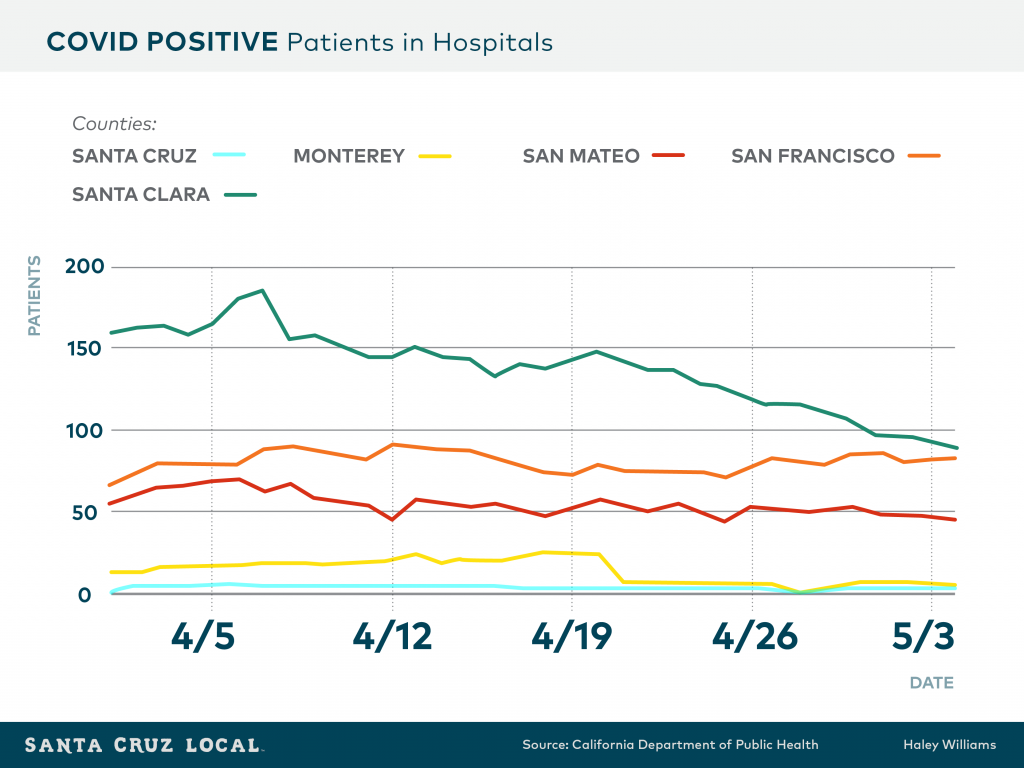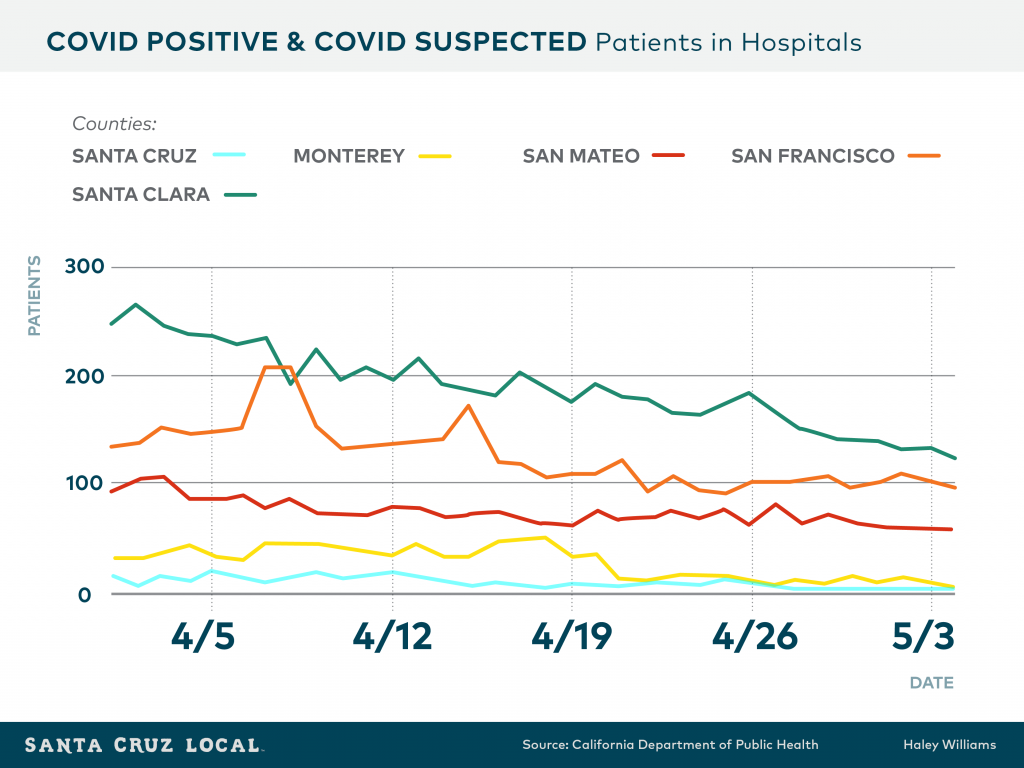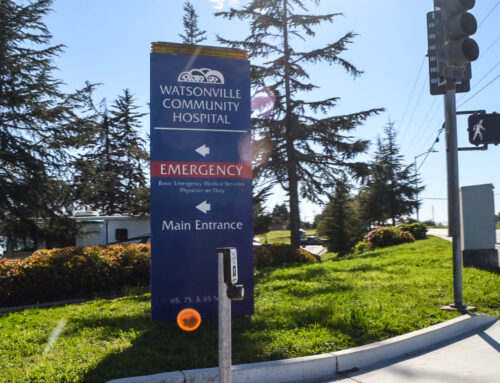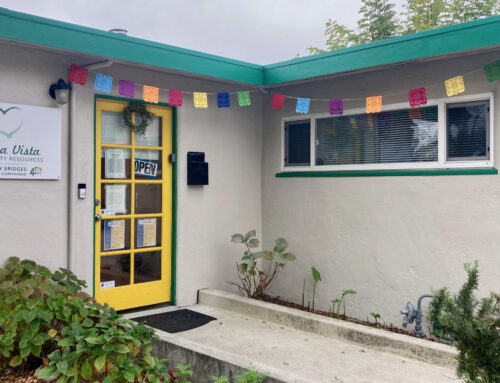SANTA CRUZ >> State hospital data show a decline in patients hospitalized with COVID-19 symptoms in Santa Cruz and surrounding counties — which are key factors in scaling back shelter orders. The challenge now lies in Santa Cruz County’s goals of conducting 400 daily COVID tests and getting more hospital gowns, eye protection and other protective gear, county leaders said.
Friday, some shops such as florists, bookstores and sporting goods stores can open for pick-up purchases only, Santa Cruz County health officials said. The move follows state guidelines released this week.


Click on the image for separate charts with interactive features.
“This step is an indicator of progress, Santa Cruz County Health Officer Dr. Gail Newel said Wednesday. “However, we remain vigilant in our efforts to reduce the spread of COVID-19, and we will carefully review our disease models for adverse impacts before reopening other sectors of our community and economy.”
How we got here
On April 2, Santa Cruz County Health Services Agency Director Mimi Hall said the number of people in hospitals with COVID symptoms each day would be an important measure in whether to dial back shelter orders. The important figure is not cumulative, but rather a daily count.
“The metric that the public should be looking for is when you see the cases go down – and particularly hospitalized,” Hall said. “You’re going to see them go up in the next several weeks. And when you see those start to go down, that means what we’re doing is working.”
Since early April, Santa Cruz Local tracked the daily number of COVID patients hospitalized in Santa Cruz, San Mateo, Santa Clara, Monterey and San Francisco counties. Data came from each county’s health department. But the data was sometimes delayed or not updated. Because the California Department of Health also tracks COVID hospitalization data directly from hospitals, Santa Cruz Local then filed a California Public Records Act request for hospital data from April 1 to the present.
Data received Monday show a recent plateau or decline in the number of COVID positive patients in hospitals in the counties of Santa Cruz, San Mateo, Santa Clara and Monterey. San Francisco shows a slight uptick in the past week.
Santa Cruz County spokesman Jason Hoppin said the declines are “really a validation for the local community.” Hoppin added, “It’s been a community sacrifice and we don’t want that to go backward.”
The number of COVID-positive patients in Santa Cruz County hospitals on a given day peaked at five patients on April 5 and 6, according to state data.
Because of delays in testing, data also was collected on the number of people in hospitals who were suspected of having COVID-19 but did not yet have test results. The number of COVID-positive and COVID-suspected patients peaked at 19 patients on April 12, according to state data.
Counties including Santa Cruz have said that 14 days of flat or declining numbers of COVID patients in hospitals would help loosen shelter orders.
One thing to note about hospitalization numbers is the lag time. It can take 14 days before a person with COVID-19 shows symptoms severe enough to be hospitalized, said Marm Kilpatrick, a UC Santa Cruz professor who studies infectious diseases.
“It’s a better indicator of what happened two weeks ago,” Kilpatrick said of daily hospitalization numbers. “It’s a terrible indicator of what’s happening now.”
Kilpatrick also said the number of new patients in hospitals each day would be a stronger gauge as to whether the county’s measures were working to limit the spread of COVID.
A few notes on the charts:
- The charts’ value is in the trajectory of the trend line in each county and less about the comparative number of hospitalizations per county. Santa Clara County has nearly 2 million people. Santa Cruz County, about 275,000; Monterey County, 430,000 people; San Mateo County, 725,000 people.
- If hospitals change COVID admittance policies, it could change trend line trajectories.
- The number of COVID patients in the hospital changes when there are new cases, recovered patients, and deaths.
- A single chart will not show whether COVID cases have peaked. Cumulative case charts are less useful because they only go up. Case counts are also a function of limited testing capacity. The combined number of suspected and confirmed COVID patients in hospital give a truer gauge, health leaders have said.
- Santa Cruz County residents and residents in many Bay Area counties are generally healthier than residents elsewhere in the nation. So fewer people might be hospitalized with COVID in those areas, according to a Dartmouth Atlas Project study. Therefore the number of people hospitalized in Santa Cruz County might not show the true prevalence of COVID.
| County | COVID-19 patients in hospital per 100,000 people |
| Santa Cruz | 0.4 |
| Monterey | 0.4 |
| Santa Clara | 1.5 |
| San Mateo | 1.9 |
| San Francisco | 3.1 |
In Santa Clara County, the decline in COVID patients in hospitals have helped shift the focus to other criteria for loosened shelter orders. Santa Clara County reached a high of 264 positive and suspected COVID patients on April 2 and has declined to 123 patients Monday.
“Because we have been extraordinarily successful in our region at suppressing cases, flattening the curve and decreasing the number of new cases that we have every day, we are hoping to successfully transition,” said Santa Clara Public Health Officer Dr. Sara Cody, in a news conference April 29. “If we can assure ourselves that there aren’t … chains of transmission that we haven’t detected and that we haven’t broken, then we can begin to ease up more.”
Where Santa Cruz County stands
Hospitalization numbers are one factor in loosening shelter rules. Santa Cruz County and Bay Area health leaders have said that five factors will help decide when and how to ease shelter order restrictions. County leaders say they expect to post an online dashboard with some of these factors and their status as early as this week.
- The number of COVID patients in hospitals each day is flat or decreasing. Santa Cruz County COVID positive patient numbers have remained fairly flat for a month. There have been one to five COVID patients since April 6.
- Hospital capacity meets residents’ needs. County leaders have said 100 intensive care unit beds and 100 ventilators and staff to operate them could be needed in a surge. The county had about 50 intensive care beds, ventilators and corresponding staff. Dr. David Ghilarducci, the county’s deputy health officer, said April 19 that it was “not likely” that the county would have many more than 50 intensive care beds. Regional hospitals would be relied upon if the need arose. Daily COVID hospital demand has never exceeded capacity in Santa Cruz County. “Caseload looks good right now,” Hoppin said this week.
- Sufficient viral detection tests conducted daily. The goal is 400 tests daily, said Hoppin. Since testing started in March, there have been about 4,400 total tests in the county, according to county data. A state partnership with OptumServe is expected to open a test site at the family center in Ramsay Park in Watsonville. Initial tests there with nasal swabs will be for first responders and health care workers, based on new state test rules. Later, about 130 daily tests are expected to be conducted there including free tests for the uninsured, Hoppin told the Pajaronian in late April. “The testing capacity is getting there,” Hoppin said this week. “Testing will soon not be a problem.” Testing from healthcare providers, UCSC and the county are included in that 400 daily test goal.
- Sufficient case investigation, contact tracing and isolation/quarantine capacity. Nonessential government workers and many retired medical professionals are expected to be trained as COVID contact tracers this month, Hoppin said. The county does not yet have a target number of trained contact tracers.
- Minimum 30-day supply of personal protective equipment for healthcare providers. “Our issue is PPE,” Hoppin said this week. “That’s the area that we really need to work on.” Demand everywhere has made it difficult for the county to secure protective gear from the state and other sources. “We send in orders and don’t get what we want,” Hoppin said. “It’s not a money thing. It’s a supply thing.” Ghilarducci said April 23 that the county ordered 136,000 gowns and received 4,600 gowns. The county ordered 33,000 units of eye protection and received fewer than 800 units. The county had sufficient N95 masks, Ghilarducci said.
Newel, Santa Cruz County’s health officer, said she expects to make changes to the county’s shelter rules every three weeks. The next rule change is due in late May.
“Even though things are going very well right now, I don’t think things are going to be normal for a while,” Hoppin said.
Santa Cruz Local’s journalism is free as a public service, but it takes time and money to produce. We depend on member support, so that everyone in our community can access fair and accurate local news. It’s time to join. Become a Santa Cruz Local member today.
Stephen Baxter is a co-founder and editor of Santa Cruz Local. He covers Santa Cruz County government.





